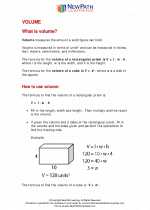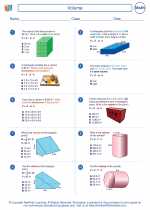Solid
A solid is a three-dimensional shape that has length, width, and height. Solids are also known as 3D shapes or geometric solids. Examples of solids include cubes, prisms, pyramids, cylinders, cones, and spheres.
Properties of Solids
1. Faces: A solid has flat surfaces called faces. Each face is a polygon.
2. Edges: The line segments where the faces of a solid meet are called edges.
3. Vertices: The points where the edges meet are called vertices.
Types of Solids
1. Cube: A solid with six square faces, 12 edges, and 8 vertices.
2. Prism: A solid with two parallel and congruent bases connected by rectangular or triangular faces. The number of vertices, edges, and faces depends on the shape of the base.
3. Pyramid: A solid with a polygonal base and triangular faces that meet at a common vertex.
4. Cylinder: A solid with two congruent circular bases and a curved surface.
5. Cone: A solid with a circular base and a curved surface that tapers to a point called the vertex.
6. Sphere: A solid with all points on its surface equidistant from the center. It has no edges or vertices.
Formulas for Solids
1. Volume:
- Cube: V = s3 (where s is the length of the side)
- Prism: V = Bh (where B is the area of the base and h is the height)
- Pyramid: V = (1/3)Bh (where B is the area of the base and h is the height)
- Cylinder: V = πr2h (where r is the radius of the base and h is the height)
- Cone: V = (1/3)πr2h (where r is the radius of the base and h is the height)
- Sphere: V = (4/3)πr3 (where r is the radius)
2. Surface Area:
- Cube: SA = 6s2 (where s is the length of the side)
- Prism: SA = 2B + Ph (where B is the area of the base, P is the perimeter of the base, and h is the height)
- Pyramid: SA = B + (1/2)Pl (where B is the area of the base, P is the perimeter of the base, and l is the slant height)
- Cylinder: SA = 2πr2 + 2πrh (where r is the radius and h is the height)
- Cone: SA = πr2 + πrl (where r is the radius and l is the slant height)
- Sphere: SA = 4πr2 (where r is the radius)
Study Guide
1. Understand the properties of faces, edges, and vertices of solids.
2. Learn the characteristics and formulas for finding the volume and surface area of different types of solids (cube, prism, pyramid, cylinder, cone, and sphere).
3. Practice solving problems involving the calculation of volume and surface area for various solids.
4. Use visual aids and models to understand the 3D nature of solids and their components.
5. Review and memorize the formulas for finding the volume and surface area of each type of solid.
By understanding the properties and formulas related to solids, you will be able to solve problems and work with 3D shapes effectively.




